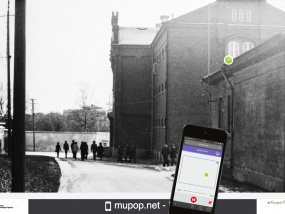Engage with digitised art
Let your visitors control the exhibition through their smartphone
SMARTPHONE INTERACTIONS
Use your visitor’s smartphone for different types of intuitive touch-screen interactions such as swiping, selecting, pointing, zooming, answering questions, selecting languages and more.
MULTILINGUAL AUDIO
Audio tours have much more impact than textual descriptions. The phone allows for personalising the audio, based on language, age and type of viewpoint at the exhibitions.
OPEN STANDARDS
Both main screen and phone use nothing more than an HTML5 web browser and an Internet connection. No need to install or develop an App Store application.
LOW-COST INSTALLATION
Any big screen with an HDMI minicomputer and a browser in kiosk mode make for a very low-cost installation. The controllers of the exhibition are in already in the pockets of your visitors.
Fashion exhibition at Sound and Vision in Hilversum
Testimonials
DIGITAL MEETS PHYSICAL
Pop-Up your exhibition anywhere and let your visitors use their smartphone to engage without technical barriers
The Pop-Up Museum offers cultural institutions and content holders in general the opportunity to showcase their digitised collections and to engage new and existing audiences with effective virtual exhibitions. Only having digital objects accessible online does not guarantee visitors a cultural experience comparable with a physical visit to a museum. For a real cultural experience we need to move the digital objects back into a physical museum-like context. This experience can be practised in museum-like venues e.g. a conference room, but also in non-typical places such as an open space, a waiting room or an entrance hall. The Pop-Up Museum is a low-cost, easy to set up, interactive cultural experience. The system is designed in such a way that cultural institutions can easily build an interactive exhibition themselves, that can be placed anywhere, designed to offer engaging digital cultural experiences to visitors at museums and art galleries, but also at locations such as waiting rooms, entrance halls, offices and classrooms. A Pop-Up Museum transforms a small portion of space into an island dedicated to art and culture, where visitors or passers-by may dwell a while, using their mobile phones or tablets to bring the screen or screens to life. The application is very low-cost, uses web-standards and requires hardware (a smart screen) that is often already at hand or can be easily adapted.
SMARTPHONES AS CONTROLLERS
Makes the visitors phone a touch-screen controller for you exhibition. Use intuitive interaction such as swiping, selecting, pointing and zooming
CHOOSE A LANGUAGE
Using the phones as controllers gives you the option the personalize the content of your exhibition into different languages
POINT AT DETAILS
Allows you visitor to use the touch-screen of their phone to point on objects in your pictures and give them in audio an explanation on these details
ANSWER QUESTIONS
Create a kind of quiz experience by pushing questions about the art objects to the visitors phone
The MuPop Team
the faces behind the digital exhibitions

Rutger Rozendal
He was the driving force in making the concept of engaging users with digital content, using devices virtually everyone carries around with them, a reality.

Daniel Ockeloen

Pieter van Leeuwen
His qualities eminently supplement Daniel’s. Their combined know-how and creativity is the basis for a sound technical roadmap for MuPop development well into the future.

David Ammeraal

Joost Baalman
Joost has extensive experience in software development and uses this expertise to manage MuPop accounts and other projects, besides making sure Noterik’s bookkeeping is in order.












